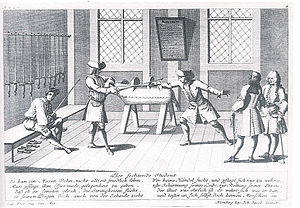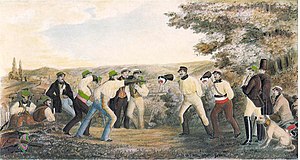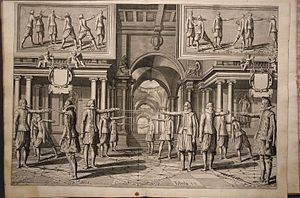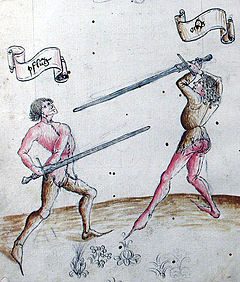With the advent of the Society for Creative Anachronism (a historical re-enactment organization founded in 1966)
there was a renewed interest in the practice of historic fighting arts. Dividing their focus between Heavy Armored Fighting, to simulate early medieval warfare, and adapted sport Rapier fencing, to reenact later renaissance styles, the SCA regularly holds large re-creation scenarios, throughout the world. Their styles are often criticized by other groups as lacking discipline and scholarship. Since the organization is effectively a collection of like-minded hobbyists (with individual exceptions), participants who view their fighting sport objectively accept it as an outlet for stress and a source of pleasure, rather than a literal re-creation of historical fighting methods.
Another approach to the reconstruction of Medieval and Renaissance martial arts in the USA was pioneered by John Clements in the mid-1980s that focused on the analysis of the works of the historical masters and realistic martial practice. In the early-1990s Clements took over the leadership of The Association for Renaissance Martial Arts (ARMA), then known as HACA (The Historical Armed Combat Association), and focused the organization on a true martial arts approach to the reconstruction of these fighting arts. To ensure that a martial focus is maintained in its reconstruction efforts ARMA excludes all sport, re-enactment, role-playing, and persona activities, as well as choreographed theatrical swordplay. ARMA also started providing to the general public the fight books of the historical masters through its web site.
During this same period several other researchers in Europe and the United States started collecting and analysing the works of the historical masters. By the late 1990s there were more groups and organizations. Since 1999 a number of these groups have held the annual Western Martial arts Workshop (WMAW). In 2001 the Historical European Martial arts Coalition (HEMAC) was created to act as an umbrella organization for groups in Europe. Since 2002, the HEMAC has organized the annual International Historical European Martial arts Gathering in Dijon, France, hosted by De Taille et d'Estoc. A number of groups and organizations who were originally focused on Medieval and Renaissance re-enactment have since changed their focus to the study of Historical European Martial arts.





